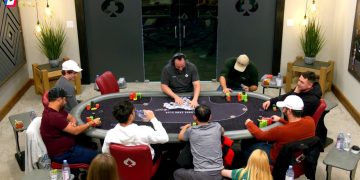Want to know a well-kept secret in the poker world? Some of the smartest business-minded poker players never play in WSOP bracelet events, WSOP ring events, WPT events, or in any other sanctioned tournaments. They don’t play cash games, either. Instead, they play poker sit and go tournaments.
Poker Sit and Go: A Smart Player
There are a few players who follow the WSOP Circuit but don’t play in any ring events. They travel to every single stop, but all they do is play sit and go poker tournaments all day. They have mastered these poker tournaments to a degree where they know they will usually be leaving with a net profit of at least $500 almost every day. Sometimes these players will stay for 12-14 days, but most of them will take a day off here and there so they can refresh.
They might go hiking, to the movies, or to the beach, depending on the location. Therefore, let’s assume that the average poker sit and go pro stays at a Circuit stop for 10 days and has a net profit of $5,000. Would you take $5,000 for 10 days of work? I’m going to guess the answer is a yes.

The $500 average for a daily net profit might seem high, but it’s not at all for someone who is focusing solely on poker sit and go tournaments. Please allow me to explain.
The average poker sit and go tournament lasts one hour, but it can be as short as 30 minutes or as long as two hours. Let’s just use one hour as the standard. We’ll also say the SNG poker pro takes two hours off for food, restroom, and other breaks.
With this information in mind, if someone starts playing poker sit and go tournaments at 10 a.m. and finishes at midnight, that would be 12 hours of play (after subtracting two hours for breaks). With the average poker sit and go tournament lasting one hour, that’s 12 poker tournaments in one day.
A lot of these will end in chops (more on that soon), but some will net $900 ($1100 – $125 buy-in and average dealer tip). The chops will usually net somewhere between $500 and $800. A lot will depend on whether it’s an even chop or an ICM chop as well as how many people are chopping. An even chop means everyone wins the same amount of money. An ICM chop means the winnings are based on how many chips everyone has. For example, the player with the most chips will win the most money.
So, let’s say the poker sit and go pro has played in 12 tournaments and cashes in four of them for an average win of $750 (net). That’s $3,000 in winnings minus 1,000 in expenses (8 x $125 in buy-ins). That’s $2,000 for the day. Despite this being a lowball estimate (only four wins in 12 tries), this is still way ahead of the $5,000 expected win for the series.
Do you see what I’m trying to say here? If you’re a beginner poker player and you want your best chance of winning in poker games on the WSOP Circuit, or your best chance of winning during the WSOP in Las Vegas in the summer, then you should definitely consider playing in these poker tournaments. They are referred to as single-table satellites by employees at the WSOP in Las Vegas, but everyone else calls them sit and go tournaments.
Poker Sit and Go: Excellent Risk/Reward
The reason the poker sit and go pros win is threefold.
#1. Experience
The most obvious reason this is often a very profitable venture is because the person who plays SNG poker tournaments all day (and sometimes all night) is going to be incredibly experienced. Most people at the WSOP in Vegas or anywhere on the WSOP Circuit are playing ring events and cash games and then playing sit and gos once in a while—usually when they have nothing else to do.
There are some people who focus more on poker sit and go tournaments, but you would be hard-pressed to find even a handful of players who focus solely on them on the Circuit. You will find more of them during the WSOP in the summer in Las Vegas, but even those players tend to drift off to different poker games. It takes a lot of discipline to stay focused on only a poker sit and go and ignore other poker games. But those who have the discipline are likely to fare well.
These players implement a simple poker strategy for SNG Poker. They know most of these poker tournaments will be chopped by two or three players at the end. When there are only 10 players in a poker tournament and you know 2-3 will be paid, the poker strategy becomes simple, especially if you can put yourself in the minds of others to see how they view these tournaments.
Everyone gets 1,000 in chips and the blind levels are only 15 minutes. This is a hyper-turbo structure. Since at least 95% of players view a poker sit and go that way, they have the mindset of Attack! Attack! Attack! If 95% of poker players have that mindset and 2-3 players usually get paid, what do you think you should do?

You should buy some popcorn prior to sitting down at the table, kick back, and enjoy the show. If an opportunity comes along where you could see a cheap flop and you hit it hard, go for the double up. Otherwise, relax, and relax in a big way.
As far as the potential double up goes, you don’t want to place many value bets because most players are rushing in these poker tournaments. Therefore, they’re usually going to call you even if they hit a small piece of the flop. If they’re playing the $125 Satellite (by far the most popular type of sit and go), then their mindset is to gamble, and if it’s a loss, try again. You need to take the opposite approach and let the gamblers come to you.
Your opponents are looking at sit and go tournaments as something fun because the buy-ins are only $125. They are not looking at it as a way to keep costs down and potential rewards high. We both know that you’re not going to win $100k in a sit and go like you might if you won a bracelet or ring event, but you must sacrifice somewhere.
You need to ask yourself: Do I want to play against the toughest competition for the big money and lose most of the time, or do I want to play against the softest competition in the house and win more often for good money? I would recommend he latter, and for one good reason.
Let’s say you want to play in the Main Event at the end of a WSOP Circuit series. The buy-in is $1,700 and first place usually pays somewhere between $150k and $300k, depending on the location. If you grind poker sit and go tournaments all week and net even $3,000 prior to the second flight of the Main Event on a Saturday, then you can buy straight in to that Main Event while still having $1,300 in winnings.
That’s not outstanding, but it sure as heck beats losing thousands of dollars by firing at ring events all week, and you get a shot at the big money to boot. Even if you didn’t cash in the Main Event, it’s an experience to remember. Additionally, you will be become a better player after playing in a Circuit Main Event. Your competition will be fierce, but that’s what makes you stronger.
#2. Chops
The pro who focuses solely on poker sit and go tournaments knows that you have a much better chance of winning money because 20%-30% of the field will be getting paid. In most poker tournaments, only 10%-15% of the field is getting paid.
I already covered this above, but think about that fact alone. You are literally doubling your chances of winning when you play sit and go poker tournaments. This is perfect for the poker tournament grinder who wants to make a living playing poker. If you want to go this route, then you’re going to need to sacrifice the potential for popularity.
For a lot of the people who play in the ring events, the money isn’t as important as being known as a great poker player. Whatever world you’re in, you’re going to want respect from your peers. I understand that, but I also like to have money. Maybe you’re more like me. And what does this paragraph tell you?
It has everything to do with Ego. Ego isn’t just your biggest threat at the poker table when you’re in the poker world. It’s also your biggest threat when you’re off the poker table. If you’re seeking popularity, that’s Ego, and that will get you into trouble. I have fallen into this trap before. At one point in my poker career, I was firing bullets at every ring event possible. I wasn’t figuring out what poker tournaments fit my style of play best, getting enough sleep, exercising, or even getting outside. It was a mess. All because I was chasing points (and money).
If you can eliminate Ego and the desire to become a popular poker player, go straight to the poker sit and go tournaments. If people didn’t have Ego and Greed, they would go straight to the sit and go tournaments.
I mention Greed because the ring events pay a ton up top, but there is absolutely nothing wrong with $5k over the course of 10 days. Greed has also led to many people going broke in this game. When you chase the big money, you’re asking for trouble.
Play the lower buy-in events against the softer competition, accumulate Benjamins, and then use some of those winnings for a ring event toward the end of the week. Even if you don’t earn enough to play in the Main Event, there are other events at the end of the week at a Circuit stop, some of which are $250. These will sometimes have a guarantee of $50k despite the small buy-in. And most of them are ring events. Nobody said you had to pay a lot of money to win a ring.
#3. Last Longer
Here is the real key to poker sit and go tournaments. When you sit down at a $125 sit and go, someone is very likely to bring up the idea of a last longer side bet. This means that everyone gives $20 to one player at the table. Whoever lasts the longest in the sit and go gets all of that money.
You might think this is redundant because the winner already won, but that’s not the point with last longers. The point is that last longers are rake-free. The house gets zero, nada, zilch. When do you see that happen? You will never see that in a bracelet or ring event. And I have never even seen it in a daily poker tournament at a regular poker room.
If we go back to the SNG Poker pro, we didn’t even include the rake-free cash earlier. Add that to the totals above and you have an absolute goldmine. But it’s a goldmine where you actually have to put work in and keep digging. It’s not the kind of goldmine where you walk inside and find gold. I believe it’s better to work hard for your money because it makes you much more likely to keep it.
Final Thoughts
Play poker sit and go tournaments whenever you can. There are numerous advantages. If you do well for the week, use part of your winnings for one of the sanctioned poker tournaments, which you can view as a reward.
In regards to poker strategy for sit and go tournaments, play much fewer poker hands than usual. You will find that most people play way too many poker hands in SNG’s, which is the exact reason you want to sit back. You always want to do the opposite of how the table is playing.
Playing in sit and go tournaments definitely fits into our poker rules for winning. In fact, I would put it toward the top of the list in our poker rules for winning. It’s not an on-the-felt poker strategy, but off-the-felt poker strategy is at least half the game. See you at the WSOP!
♠ pokerjournal.org
Poker Sit and Go – FAQ
What is a Sit and Go in poker?
A Sit and Go is a one-table poker tournament. It usually lasts around one hour but can go as long as two hours.
How do sit and go poker tournaments work?
For Sit and Go poker tournaments, you buy-in at the table, receive a small stack of chips, and play against nine other players. The last player left wins, but it's usually a chop between two or three players, depending on chip stacks.
What is a good strategy for sit and go poker?
You want to be patient early. Watch other players knock themselves out. As blinds go up, you need to start attacking. Once you're first or second in chips, slow down again until you're down to three. At that point it will be either a chop or you can apply pressure by knowing that the two other want the head-up chop and will be conservative.
How do you make money playing sit and go poker?
Follow the strategy above and you should do well. SNGs are one of the best types of tournaments to play because you're also getting rake-free money on the all-cash last-longer bets between players.


















Discussion about this post